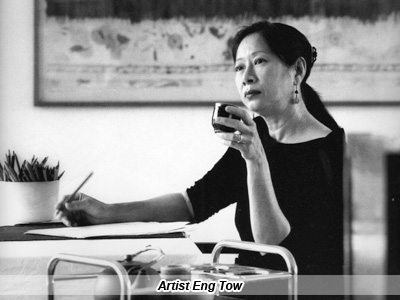Shoppers at the revamped
Heartland Mall have every reason to cheer the opening of
Kovan station, which provides convenient access to this
retail development. The
station entrances were designed to incorporate structural
steel with a curved aluminum canopy, which creates a
streamlined effect.
With the station,
residents in Kovan can now gain easy access to the rest of
Singapore while enjoying the convenience of the commercial
developments around the
station.
Eng Tow was drawn to the
historical reference of topographical maps as a device to
subtly prompt questions about our lives and times. She
placed two maps of the
Kovan/Upper Serangoon area on the train platform.
These "documents of time"
offer a snapshot of the geography, sociology and history of
Kovan and its residents.
In the map of early times,
commuters will notice that major roads like Serangoon Road
and Tampines Road already existed, but side by side with
mangrove
swamps and forested areas, plantations and water bodies.
The commentary on modern
times shows a network of road arteries devoid of vegetation
and is made up of only one type of granite.

The maps are formed from
coloured granite in-lays in earth tones like ochre, black,
dark green, red and grey. Granite was chosen because it is
an indigenous stone
familiar to Singaporeans. The stones were cut using
technology that has only recently become available in
Singapore. Like a giant jigsaw puzzle, the pieces fit snugly
and comfortably together, set against the buff background of
the platform floor.
The difference in pattern
and format of the two maps reflect the changes in lifestyle
that resulted from the development, transportation and now
globalisation of
Singapore. In abstract terms, the early Singapore work makes
an agricultural statement that is curvilinear and organic
whereas the graphic statement of the modern
Singapore map is very much geometric in form.
Back To Top
One of the LTA's aims for
the Art in Transit programme was for the artists to create
works that commuters may interact with at various levels.
Eng Tow's work at the
station does this by injecting a gentle note of irony into
the maps. The maps are located in an MRT station, the
embodiment of a fast-paced urban lifestyle.
The 'past' and 'present'
Singapore maps juxtapose areas of form versus void,
emphasising and de-emphasising respectively, the priorities
of the times.
To complement the
floorworks, the artist originally designed wall panels for
the station by inscribing cartographic symbols, such as
icons for mangrove, rubber and
coconut trees on the surface of the proposed GRC (glass
reinforced concrete) panels.
From a distance, the
walls, which were to be buff coloured, would be seen as
patterned panels; closer up people would discover different
icons making up different
patterns on each panel.
Mechanical and engineering
requirements at the station meant that the idea for wall
patterns was not feasible. The artist however found another
way to re-emphasise
the agricultural concept on the floor. Icons in stainless
steel are scattered randomly throughout the floors of the
station's concourse level. At each of the three
entrances, only one particular icon is used, uniquely
identifying its signature to commuters in a subtle, graphic
manner.

Back To Top
When you first step into
the station, you see only the icon associated with the
particular entrance you used. As you move deeper into the
station concourse, that icon
merges with other icons creating a surprise discovery trail.
Eng Tow's work is widely
regarded as one of the more sophisticated, thoughtful
expressions of integrated art on the North East Line.

The artist does not expect
commuters to take in the full meaning of her work in one
glance. Age and life experience will influence how people
respond to the works.
There might be people who only discover the maps after years
of travelling through the station.
It is this very simplicity
that makes the maps at Kovan station a fitting backdrop for
a daily tableau of life and art. Inside the station, the
early and modern Singapore
works are placed on either side of the lift shaft at
platform level. Once they walk down the stairs or use the
lift, commuters become inadvertent performers,
interacting physically and visually with the map. As they
cross the platform, they may well be tracing the outline of
the current Tampines Road. As they wait for the
train, they could be standing on a drawing of wetlands that
existed in the area. In short, just about every commuter on
the platform of Kovan station becomes part of
an ever-evolving artwork.
Eng Tow hopes that
commuters would ponder what Singapore has gained in the
march of progress and what Singapore may have sacrificed
through her thought-
inducing maps and artworks.
Artist:
Eng Tow
Born: Singapore, 1947
Education:
- Bachelor of Arts, 1972
Winchester School of Art, Hampshire, UK
- Master of Arts, 1974
Royal College of Art, London, UK
next: Hougang station
Back To Top